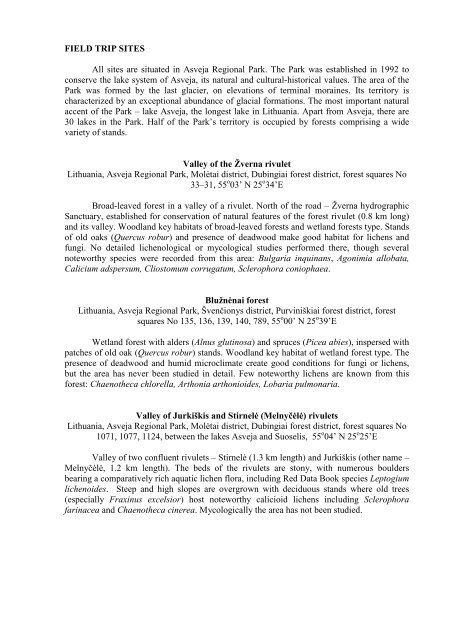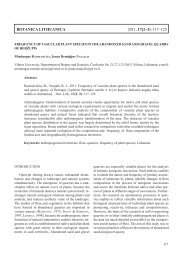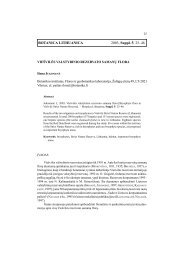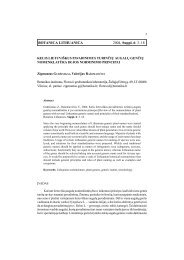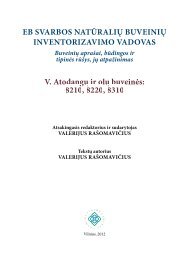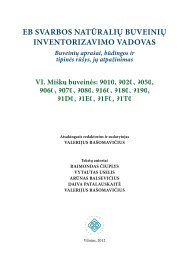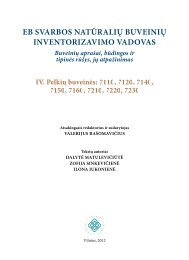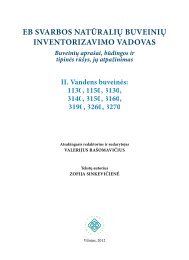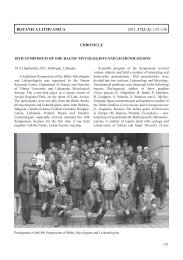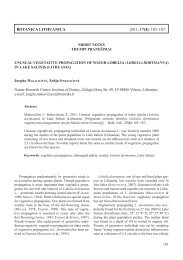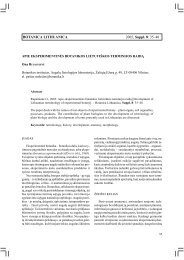FUNGI AND LICHENS IN THE BALTICS AND BEYOND XVIII ...
FUNGI AND LICHENS IN THE BALTICS AND BEYOND XVIII ...
FUNGI AND LICHENS IN THE BALTICS AND BEYOND XVIII ...
You also want an ePaper? Increase the reach of your titles
YUMPU automatically turns print PDFs into web optimized ePapers that Google loves.
FIELD TRIP SITES<br />
All sites are situated in Asveja Regional Park. The Park was established in 1992 to<br />
conserve the lake system of Asveja, its natural and cultural-historical values. The area of the<br />
Park was formed by the last glacier, on elevations of terminal moraines. Its territory is<br />
characterized by an exceptional abundance of glacial formations. The most important natural<br />
accent of the Park – lake Asveja, the longest lake in Lithuania. Apart from Asveja, there are<br />
30 lakes in the Park. Half of the Park’s territory is occupied by forests comprising a wide<br />
variety of stands.<br />
Valley of the Žverna rivulet<br />
Lithuania, Asveja Regional Park, Molėtai district, Dubingiai forest district, forest squares No<br />
33–31, 55 o 03’ N 25 o 34’E<br />
Broad-leaved forest in a valley of a rivulet. North of the road – Žverna hydrographic<br />
Sanctuary, established for conservation of natural features of the forest rivulet (0.8 km long)<br />
and its valley. Woodland key habitats of broad-leaved forests and wetland forests type. Stands<br />
of old oaks (Quercus robur) and presence of deadwood make good habitat for lichens and<br />
fungi. No detailed lichenological or mycological studies performed there, though several<br />
noteworthy species were recorded from this area: Bulgaria inquinans, Agonimia allobata,<br />
Calicium adspersum, Cliostomum corrugatum, Sclerophora coniophaea.<br />
Blužnėnai forest<br />
Lithuania, Asveja Regional Park, Švenčionys district, Purviniškiai forest district, forest<br />
squares No 135, 136, 139, 140, 789, 55 o 00’ N 25 o 39’E<br />
Wetland forest with alders (Alnus glutinosa) and spruces (Picea abies), inspersed with<br />
patches of old oak (Quercus robur) stands. Woodland key habitat of wetland forest type. The<br />
presence of deadwood and humid microclimate create good conditions for fungi or lichens,<br />
but the area has never been studied in detail. Few noteworthy lichens are known from this<br />
forest: Chaenotheca chlorella, Arthonia arthonioides, Lobaria pulmonaria.<br />
Valley of Jurkiškis and Stirnelė (Melnyčėlė) rivulets<br />
Lithuania, Asveja Regional Park, Molėtai district, Dubingiai forest district, forest squares No<br />
1071, 1077, 1124, between the lakes Asveja and Suoselis, 55 o 04’ N 25 o 25’E<br />
Valley of two confluent rivulets – Stirnelė (1.3 km length) and Jurkiškis (other name –<br />
Melnyčėlė, 1.2 km length). The beds of the rivulets are stony, with numerous boulders<br />
bearing a comparatively rich aquatic lichen flora, including Red Data Book species Leptogium<br />
lichenoides. Steep and high slopes are overgrown with deciduous stands where old trees<br />
(especially Fraxinus excelsior) host noteworthy calicioid lichens including Sclerophora<br />
farinacea and Chaenotheca cinerea. Mycologically the area has not been studied.


